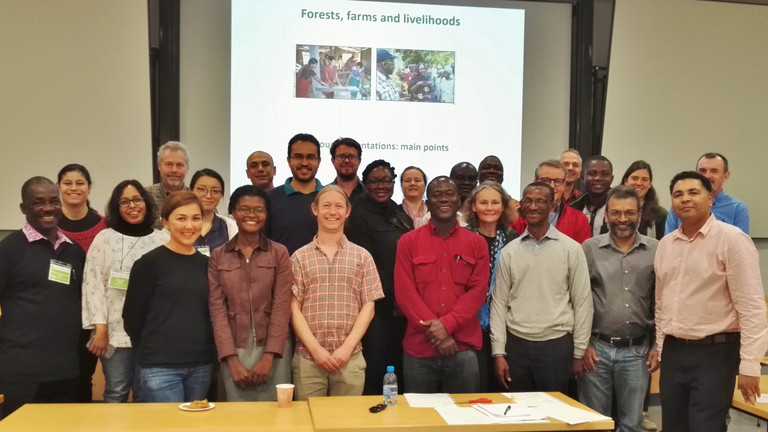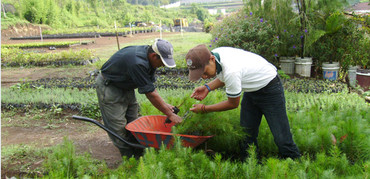Incendiary observations from the 4th FLARE conference
Researchers into forest livelihoods recently met in Copenhagen to share ideas on how to support forests, sustainable forestry and forest peoples. Duncan Macqueen reports back on some of the highlights.


A community-owned Mexican sawmill in Oaxaca (Photo: Copyright Duncan Macqueen)
Envious glances accompanied my departure to Copenhagen for the 4th annual meeting of FLARE (Forests & Livelihoods: Assessment, Research, and Engagement). I don’t think it was just because of the opportunity to sample Danish Frikadeller (meat balls) or Leverpostej (liver paste) – although both are delicious.
FLARE brings together an eclectic bunch who are all working to help people in forests. The aim is mutual learning about more efficient ways to improve forest livelihoods around the world. Don’t knock ‘mutual learning’ – that’s how the sparks of good ideas flare up, leaping from place to place: hence the name.
This year’s conference featured many presentations in five parallel sessions. One cannot get to everything, but at the risk of crass over-simplification, here is what stuck out for me:
- The expansion of industrial-scale agriculture continues to be the big destroyer of the world’s remaining tropical rainforests. Oil palm is one of the big culprits, but soybeans and cattle are doing their share of damage
- Growing populations, especially in Africa, need more land for smallholder subsistence agriculture and wood fuel for cooking (the biggest use of wood by volume and value in much of the developing world). People need to eat – but there are big opportunities to improve food security while also enriching tree cover, as I explain below
- Mining and infrastructure development are the third major cause of forest loss and equally difficult to counter.
You will notice that I have not mentioned logging. Logging in tropical rainforests mostly extracts single trees while leaving the forest canopy intact. Logging roads open up access for agricultural conversion – but in the big picture, logging in tropical forests is scarcely at the deforestation party, notwithstanding the money lavished on halting illegal logging through the EU action plan on Forest Law Enforcement Governance and Trade (FLEGT).
Turning to the big culprit – industrial-scale agriculture – there is lots going on. Most efforts aim to stem a powerful economic tide in favour of local justice. Those making industrial-scale private sector pledges towards ‘zero deforestation’ were surprisingly thin on the ground at the Copenhagen conference – perhaps because it has little to offer forest livelihoods?
Instead, talks focused on issues such as how a new legal toolkit from ClientEarth could help fight for Free Prior Informed Consent (FPIC) before forest conversion is signed off by governments. Work with subnational governments to improve land use planning and help local communities to defend their territories also featured strongly.
Payment systems such as REDD+ continue to struggle to turn the tide in any meaningful way. Forest-risk commodities such as oil palm continue to pursue certification for ‘sustainability’, but that is unlikely any time soon.
But what of the big opportunity – subsistence agriculture? This is causing considerable forest conversion and degradation, especially in Africa, as showcased in case studies from the Miombo Woodland (data from the University of Edinburgh). Forest degradation from the extraction of fuel wood, for example, is significant. It is having negative impacts on biodiversity – although, surprisingly, not on livelihoods as yet.
Forest conversion and degradation go on, despite the fact communities (such as in Ghana) make as much as 21% of their income from forest resources. Often this is because communities have insecure tenure and so don’t protect what is not theirs.
Despite this, researchers studying how economic development and population growth affect forest cover over time are finding no clear correlation between increasing population and forest loss (Roma Tre University). In other words, even in densely populated areas forests and trees can flourish over time. But under what conditions?
The University of Connecticut analysed thousands of studies on forest restoration and found that community forestry and agroforestry are where win-wins for poor people and forests can go hand in hand. They found that if they have secure forest tenure rights (and that's a big 'if'), subsistence and commercial farmers who live with the consequences of their land use decisions are pretty good at forest restoration and protection – better even than those managing protected areas. Many speakers, including those from Conservation International, highlighted the tricky business of fighting for local forest tenure rights.
With the right tenure and market conditions, forest restoration can happen quickly. For example, in Tanzania over the last decade, smallholder farmers have been planting considerably more trees than either the state forest department or forest industries, according to early results research at the University of Wisconsin.
In Sahelian landscapes, the more inclusive of both men and women forest restoration efforts were, the more diverse the plantings were and the more livelihoods benefited, according to a presentation by CIFOR.
Participants generally agreed that more support is needed to realise the potential of diverse on-farm tree-growing and natural forest production schemes. Cooperative business models that can mobilise the rural masses need assistance if they are to deliver widespread benefits to people and planet. Using new technologies in production and marketing can either help to stem youth out-migration or make the most of it (through sending back remittances and knowledge).

To mobilise support we need to make governments and donors aware of the huge potential of sustainable smallholder forestry. IIED and FAO partners at the Forest and Farm Facility helped to facilitate a workshop that discussed improving the data on that potential. Existing estimates (PDF) put global gross product from forest and farm smallholders at between US$0.88 to 1.5 trillion. But the data is still poor, especially for smallholder timber, which probably accounts for the majority of global production.
Participants agreed to join forces in a new FLARE working group to improve not only the data on smallholder production, but also on the factors that motivate smallholders to plant trees and care for natural forests.
Given the vast numbers of smallholder producers, finding ways to increase investment into their agroforestry systems will be critical if we are to achieve the Sustainable Development Goals and Paris climate agreement.


